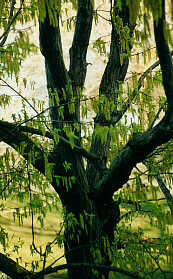The City Naturalist
American Hornbeam Tree
Article and Photos by Leslie Day
AMERICAN HORNBEAM Carpinus caroliniana
Common Names: Musclewood, Ironwood, Blue-beech, Water-beech. The
word "hornbeam" comes from the words "horn"
for "toughness" and "beam" an old English
word for "tree" and refers to this tree's very hard,
tough, wood.
DESCRIPTION: The Hornbeam is a small tree
whose smooth, fluted, dark gray trunk has a distinctly muscular
appearance--a deeply ridged and sinewy look. The Hornbeam reaches
a height of 30 feet with a trunk measuring l foot in diameter.
 LOCALLY:
There are many Hornbeam trees here in Riverside Park. The male
catkins are truly beautiful when they emerge in late March before
the leaves, and hang suspended. Long, delicate, and brilliant
green, they are among the first greenery we see and truly a sight
for sore, winter-logged eyes. The bark stands out because it
looks sinewy and strong and in fact covers a wood that is one of
the strongest one can find in a tree. "The smooth bark seems
to be corrugated with some sort of swelling or twisting inside
the wood itself, as if the life within showed itself proudly, as
a young man will flex his arm in the joy of its strength."
(Peattie, 1948, p. 156)
LOCALLY:
There are many Hornbeam trees here in Riverside Park. The male
catkins are truly beautiful when they emerge in late March before
the leaves, and hang suspended. Long, delicate, and brilliant
green, they are among the first greenery we see and truly a sight
for sore, winter-logged eyes. The bark stands out because it
looks sinewy and strong and in fact covers a wood that is one of
the strongest one can find in a tree. "The smooth bark seems
to be corrugated with some sort of swelling or twisting inside
the wood itself, as if the life within showed itself proudly, as
a young man will flex his arm in the joy of its strength."
(Peattie, 1948, p. 156)
FLOWERS and FRUIT: The male flowers
(staminate catkins) emerge in late March and hang down like long,
slender, green chandeliers. The female flowers (pistillate
catkins) emerge from the tips of the branches and, once
pollinated, grow into small ovoid nutlets; each one being
enclosed in the base of a 3-lobed, leaf-like bract which are
borne in pairs in rather loose and drooping clusters. These nuts
are eaten by many birds and by squirrels. In the suburbs and
rural areas, the fruit is eaten by ruffed grouse, bobwhite,
pheasant and wild turkey. Cottontail rabbit and white-tailed deer
nip the shoots of this tree.
 LEAVES:
Similar to beech leaves, the Hornbeam leaves are thin and
beautifully translucent. However there are many leaves giving a
dense appearance and providing much cool shade in summer. In late
autumn the leaves turn deep scarlet and orange. The leaves are
finely and sharply double-toothed. They are thin but firm in
texture, dark green above and paler beneath, smooth with
long-pointed tips and rounded bases.
LEAVES:
Similar to beech leaves, the Hornbeam leaves are thin and
beautifully translucent. However there are many leaves giving a
dense appearance and providing much cool shade in summer. In late
autumn the leaves turn deep scarlet and orange. The leaves are
finely and sharply double-toothed. They are thin but firm in
texture, dark green above and paler beneath, smooth with
long-pointed tips and rounded bases.
WOOD: The wood of the Hornbeam tree is heavy, hard, tough, strong, and durable. Early settlers used it to make bowls and dishes, as this wood is not subject to cracks or leaks. The wood is so strong it is used on Rolls Royces outside the side doors. The wood has also been used for levers, home-made tool handles, and fuel.
HABITAT: Moist rich soils, mainly along streams and in ravines; in understory of hardwood forests.
RANGE: Ontario south to central Florida, west to East Texas and north to Minnesota. Also in the mountains of Mexico and Central America.
BIBLIOGRAPHY:
The Audubon Society Field Guide to North American Trees,
1980, Alfred A. Knopf, New York.
The Illustrated Book of Trees, Grimm, William C., 1983,
Stackpole Books, Harrisburg, Pa.
A Natural History of Trees of Eastern and Central North
America, Peattie, Donald Culross, 1991, Houghton Mifflin
Co., Boston.
Golden Guide to Trees of North America, C. Frank
Brockman, 1986,Golden Press, New York
About Leslie Day | For Further Information
Copyright © 1996-2012 The 79th Street Boat Basin Flora and Fauna Society.

